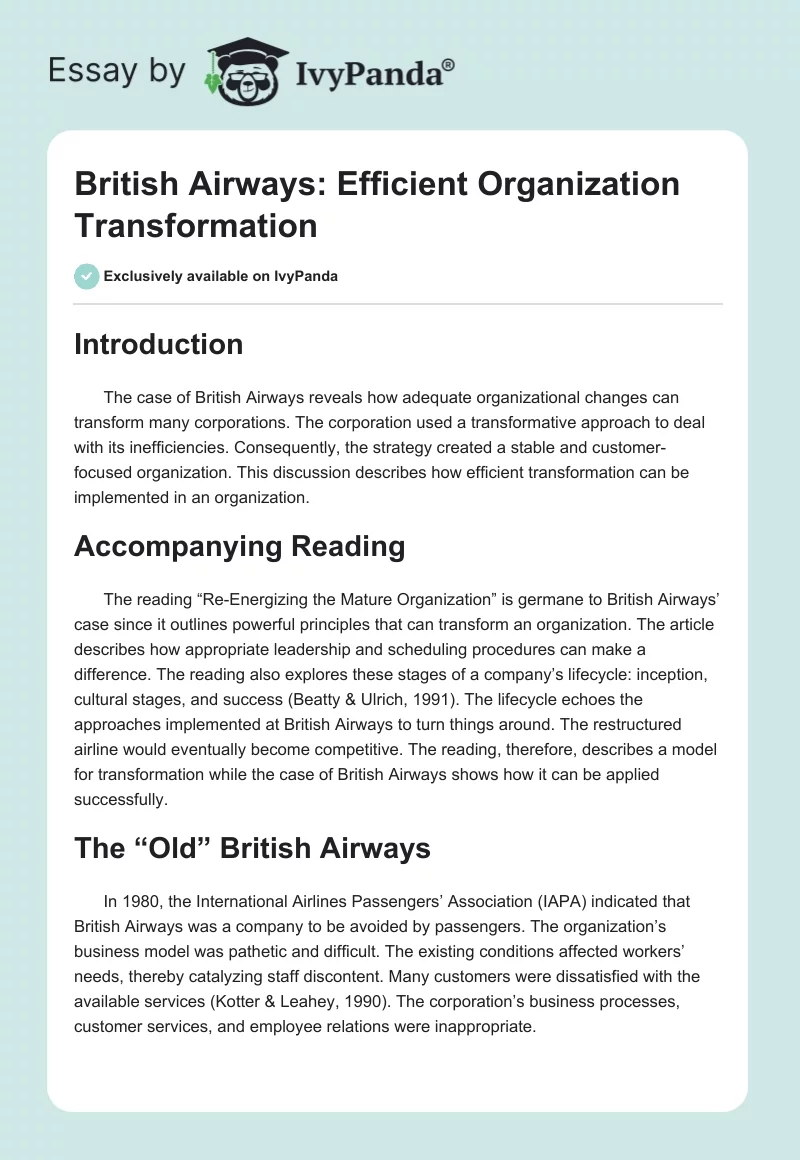Introduction
The case of British Airways reveals how adequate organizational changes can transform many corporations. The corporation used a transformative approach to deal with its inefficiencies. Consequently, the strategy created a stable and customer-focused organization. This discussion describes how efficient transformation can be implemented in an organization.
Accompanying Reading
The reading “Re-Energizing the Mature Organization” is germane to British Airways’ case since it outlines powerful principles that can transform an organization. The article describes how appropriate leadership and scheduling procedures can make a difference. The reading also explores these stages of a company’s lifecycle: inception, cultural stages, and success (Beatty & Ulrich, 1991). The lifecycle echoes the approaches implemented at British Airways to turn things around. The restructured airline would eventually become competitive. The reading, therefore, describes a model for transformation while the case of British Airways shows how it can be applied successfully.
The “Old” British Airways
In 1980, the International Airlines Passengers’ Association (IAPA) indicated that British Airways was a company to be avoided by passengers. The organization’s business model was pathetic and difficult. The existing conditions affected workers’ needs, thereby catalyzing staff discontent. Many customers were dissatisfied with the available services (Kotter & Leahey, 1990). The corporation’s business processes, customer services, and employee relations were inappropriate.
Barriers to Change
British Airways failed to implement new changes due to various factors. For instance, its parent companies supported a rigid culture that was hard to transform. Although the organizations operated effectively, the level of efficiency was quite low (Kotter & Leahey, 1990). Notably, parent corporations were making adequate profits. However, this performance discouraged the leaders from focusing on efficiency (Peronja, 2015). Consequently, the managers were unable to implement meaningful changes.
Transforming British Airways: Critical Factors
The first critical factor that facilitated the transformation was the appointment of John King. The chairman’s experience empowered him to implement a powerful change process. Dunlop Gordon, the new Chief Finance Officer, changed the airline’s image by retaining various services. Additionally, Colin Marshall applied powerful strategies to deliver exemplary services (Kotter & Leahey, 1990). The Putting People First program was another crucial aspect that empowered employees to interact positively and support customers’ needs.
Transforming Themselves
British Airways’ stakeholders identified various steps and sequences to transform the company. The chairman implemented a powerful plan using several steps. The first one was to reduce the number of workers. This was followed by freezing salary increments (Kotter & Leahey, 1990). The third step was to shut sixteen routes. This sequence was used: operational changes, engagement of workers, and customer support. The major risks included the move to reduce the number of employees and transform the organization’s business model.
What I Would Have Done: Biblical Integration
Marshall and King focused on issues such as employee empowerment, customer satisfaction, and service delivery. However, I would have gone a step further to introduce powerful schemes to ensure more people embraced the company’s services. Kurt Lewin’s model (refreeze-change-freeze) could be applied to promote new practices at the company (Burnes, 2009). Joint marketing strategies could have also been used to maximize profitability (Andrews, Beynon, & Genc, 2017). Every worker would be encouraged to embrace virtues such as integrity, respect, ethics, and truth (Abdullah, Chew, & Hamid, 2016). Such attributes would ensure that the airline exhibits the nature of God.
Conclusion
This discussion explains why companies should make appropriate transformations to remain competitive. The use of powerful incentives can deliver meaningful results. The involvement of different stakeholders can transform a company’s image and make it more competitive.
References
Abdullah, M., Chew, B., & Hamid, S. (2016). Benchmarking key success factors for the future green airline industry. Procedia – Social and Behavioral Sciences, 224, 246-253. Web.
Andrews, R., Beynon, M. J., & Genc, E. (2017). Strategy implementation style and public service effectiveness, efficiency, and equity. Administrative Sciences, 7(4), 1-19. Web.
Beatty, R. W., & Ulrich, D. O. (1991). Re-energizing the mature organization. Web.
Burnes, B. (2009). Managing change: A strategic approach to organizational dynamics. Upper-Saddle River, NJ: Prentice Hall.
Kotter, J. P., & Leahey, J. K. (1990). Changing the culture at British Airways. HBS No. 491-009. Boston, MA: Harvard Business School Publishing.
Peronja, I. (2015). Performance effects of the business process change in large enterprises: The case of Croatia. Management, 20(1), 1-22.


